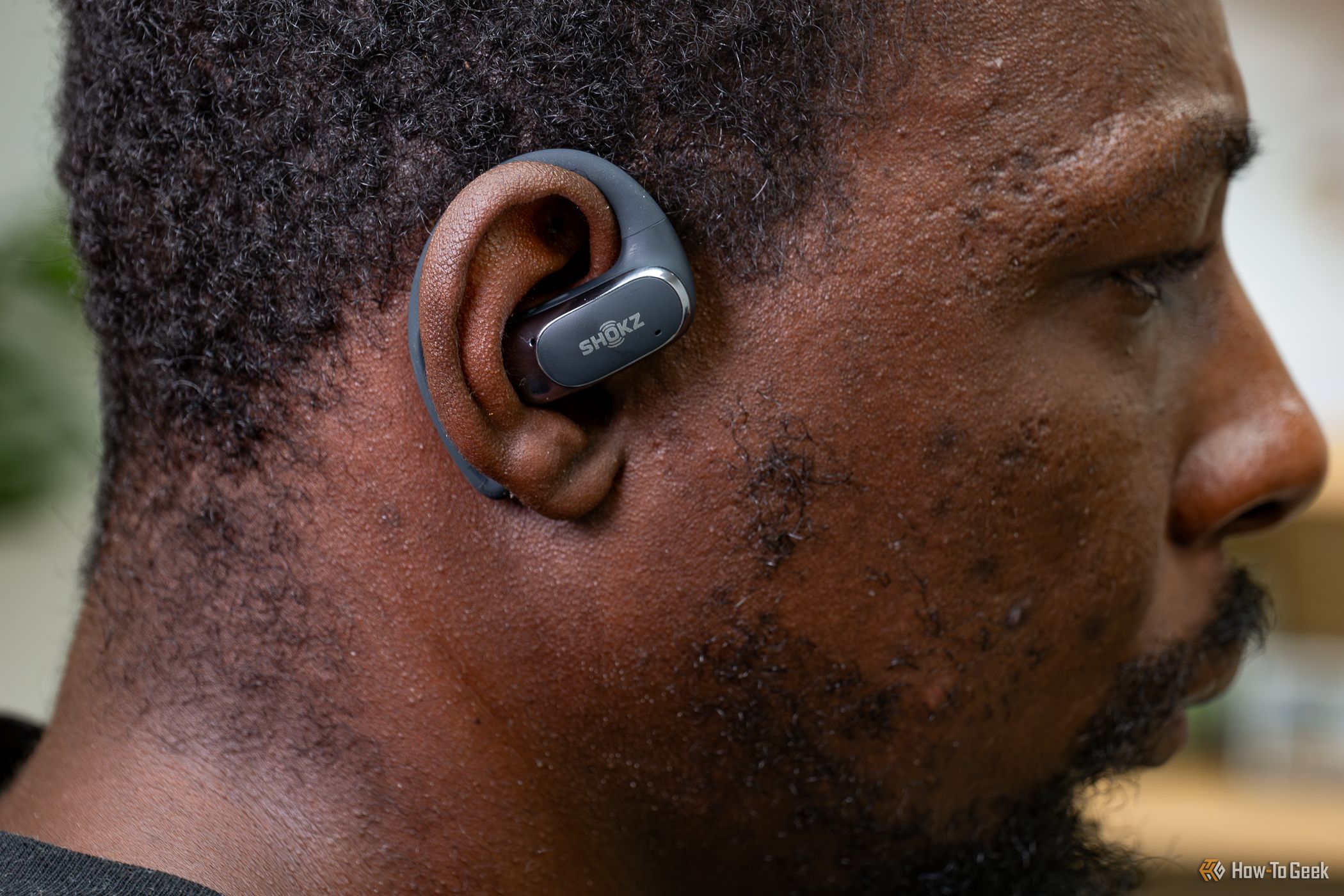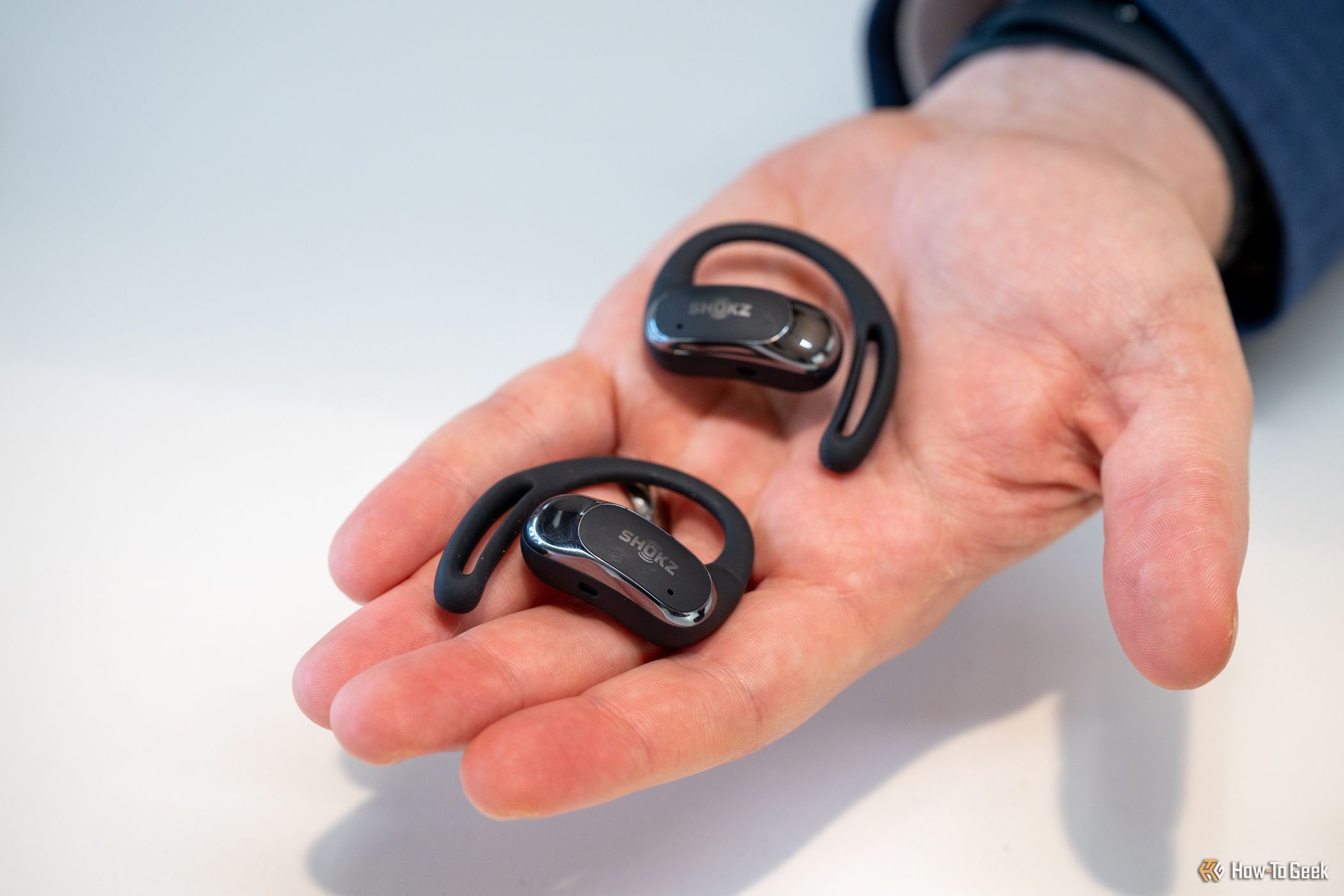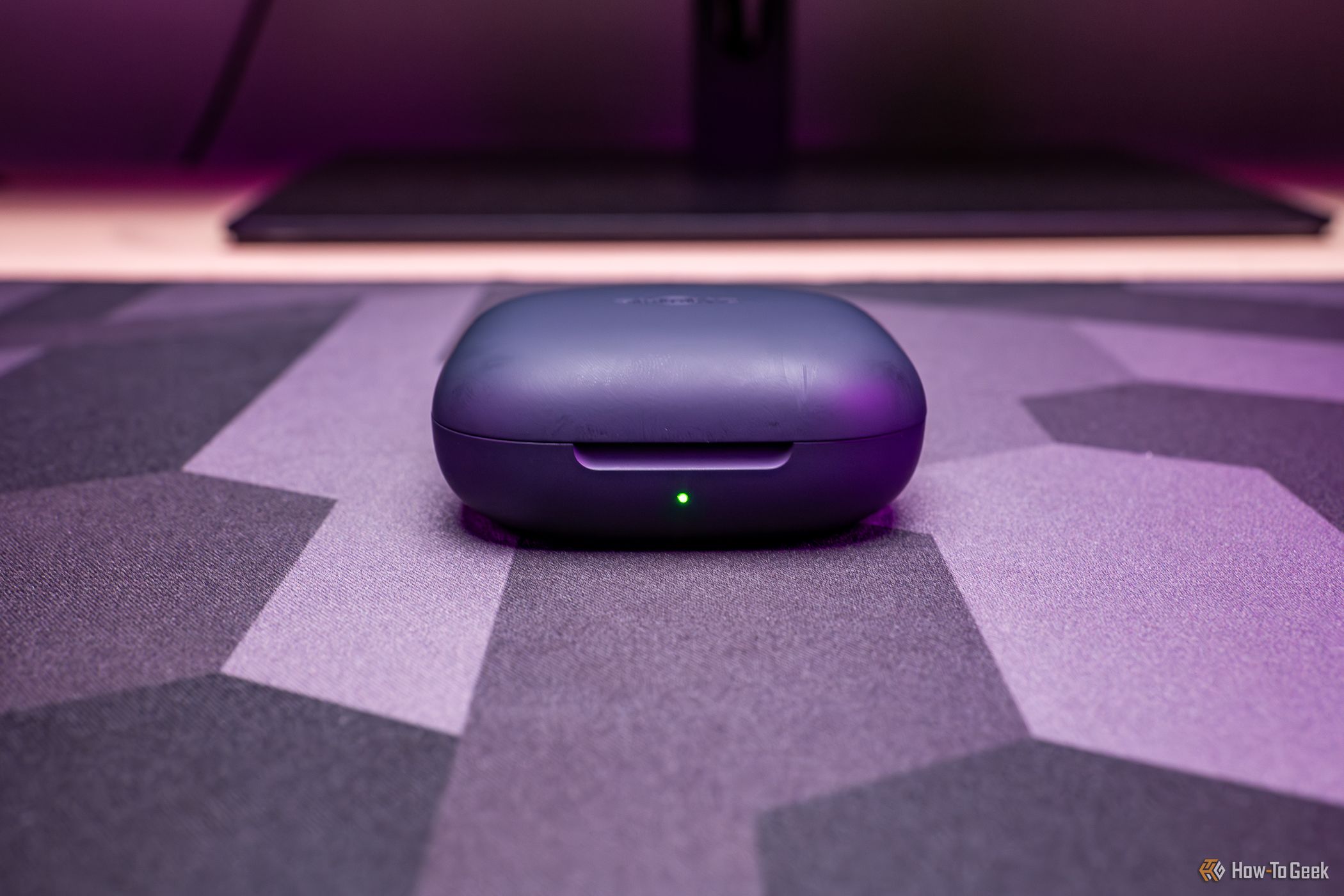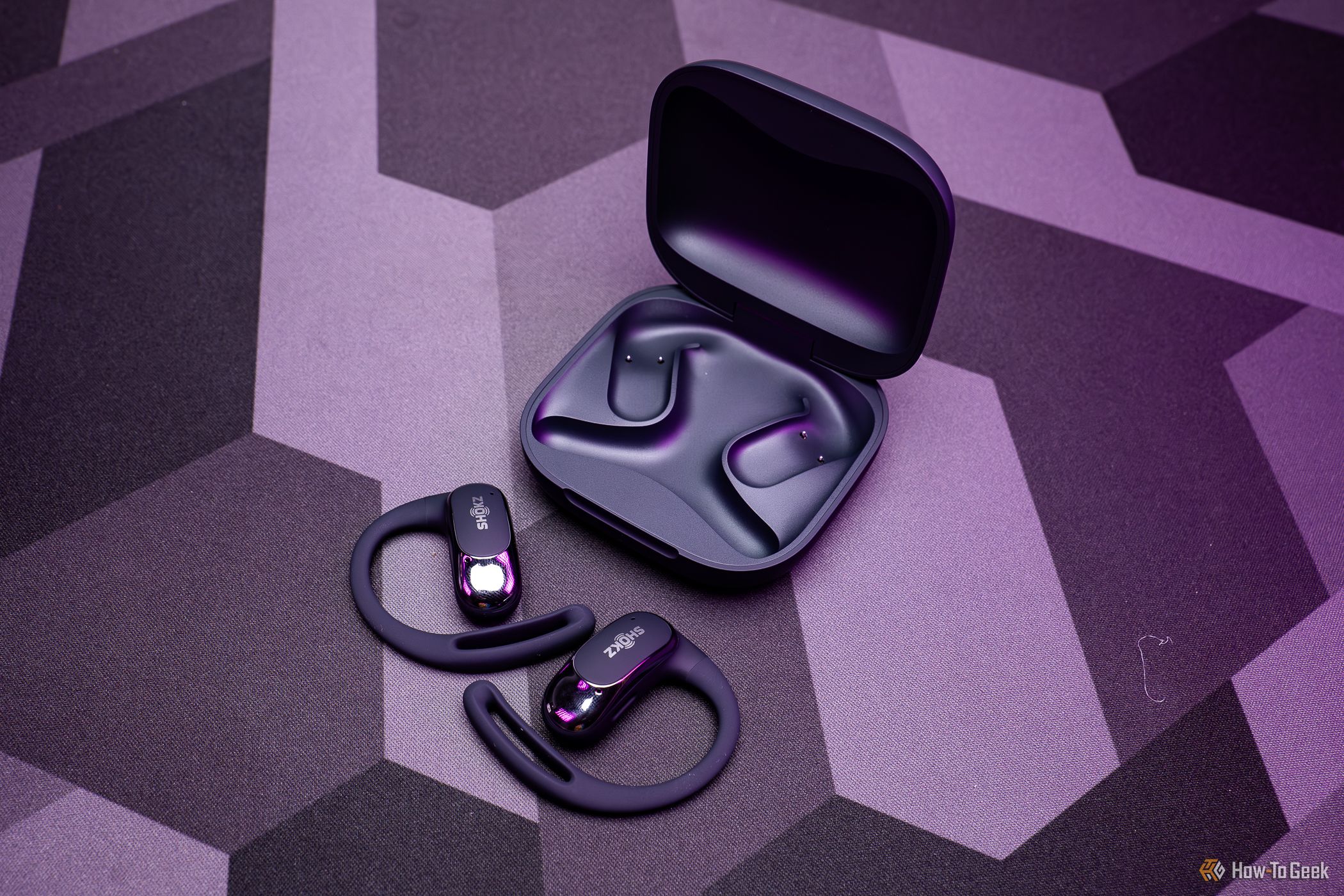Key Takeaways
- The Shokz OpenFit Air earbuds offer a comfortable fit and clear sound without blocking ambient noise.
- Excellent battery life with up to six hours on a single charge and up to 28 hours with the case keeps you listening for days.
- Some shortcomings include poor EQ settings, lack of customization for touch controls, and sweat affecting the touch controls.
While I like in-ear wireless earbuds for many activities, the Shokz OpenFit Air earbuds made being active while listening to music and audiobooks a little more convenient, thanks to their soft, flexible ear hooks. Their design made me aware of my surroundings, making these buds my favorite accessory for gym trips. Some shortcomings, however, like lack of customization and poor EQ settings, may give some buyers pause.
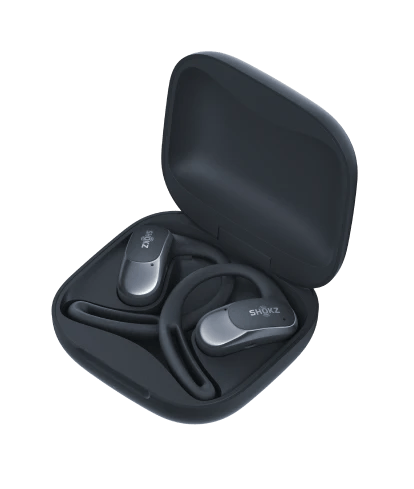

Shokz OpenFit Air Earbuds
The Shokz OpenFit Air earbuds feature a signature flexible nickel-titanium alloy with a soft silicone and a dual-bevel design that makes them comfortable to wear all day while delivering clear sound without blocking out ambient noise.
- Excellent audio and volume in standard listening mode
- IP54 water and sweat resistance
- Stays secure and comfortable on ears while walking, running, and exercising
- Multi-Point Pairing
- Quad microphones make for clear phone calls
- Poor Preset EQ Settings
- No full customization for touch controls
- Water and sweat occasionally affects touch controls
- Audio quality loses something compared to in-ear buds
Price and Availability
The Shokz OpenFit Air earbuds are available to order now on Shokz’s website, Amazon, and Best Buy. The headphones retail for $199.95 in each color.
Comfortable Enough for All-Day Wear Everywhere
Although I had a problem adjusting to the fit of the Shokz OpenFit Air earbuds on my first day wearing them, I soon got over it. I could easily slip the flexible ear hooks around my ears, while the dual-bevel earbuds conformed to the shape of my ears so well that I almost couldn’t feel them. The dual bevel supposedly shifts the center of gravity closer to your ears for a lightweight fit, and that was my experience.
Their minuscule weight (the specs say 0.3 ounces, but when I weighed them, my scale read 0.4 ounces per bud) made them easy to wear for hours. When I say hours, I mean hours. I regularly wore the Shokz OpenFit Air earbuds during my entire work day; some days, I wore them to the gym afterward. While they aren’t marketed specifically for runners, as the Shokz OpenRun Pro Headphones were, I found them excellent on treadmill runs and during other gym activities. These are meant primarily for anyone (athletes or otherwise) who needs to remain aware of their surroundings.
I could still converse with people while listening, as long as the volume wasn’t too high. But I did find the fit made me feel somewhat unsatisfied with the music at times. I occasionally turned the volume up to particularly high levels at the gym to feel more immersed. I’m a self-proclaimed blaster of music in general, but I noticed it was harder to hear the music in noisier areas. The design has limits — it doesn’t give the same close-up audio effect as earbuds inside your ears.
Additionally, the audio was somewhat audible to people around me at mid to high volumes, which can be a bit annoying. Last, in terms of design, is the charging case, which was on the larger side. It was awkward in my workout pockets, but its bulk still fit inside any pants pocket or purse.
Good Sound Quality With Decent Bass
The OpenFit Air earbuds have what the brand calls Shokz OpenBass Air, a low-frequency enhancement that brings detail and deep bass. Compared with my Beats Studio Buds (which are a couple of years old now), the bass on the Shokz OpenFit Air was more satisfying (not surprising), and I did hear more richness in the audio quality.
What I appreciated about the Shokz OpenFit Air earbuds was the consistency. When I had them on “Standard Mode” (no EQ), every song I played, no matter the genre, sounded incredible. From Leon Bridges’ soulful vocal-forward Laredo to Sleep Token and Loathe’s moody piano ballad Is It Really You?, I got balanced sound through mids and trebles, with a satisfying bass.
With IP54 sweat and water resistance, I could complete hardcore workouts on treadmills and stair climbers (while I was literally dripping sweat) without worrying. Meanwhile, on the outer side of the earbuds are the touch controls. A couple of quick taps or long presses helped me switch songs or hit pause.
But when I was dripping sweat or had wet hair, it triggered the long-press control, which either turned the volume up or down depending on which earbud it was. This happened a few times and resulted in my eardrums hurting before I could remove the bud, wipe it off, and adjust the volume back to a comfortable level.
The Shokz App
Shokz’s companion app (available on iPhone and Android) was satisfactory, but it was bare-bones. Most upsetting to me was the fact that I couldn’t fully customize the touch controls. When I hit “Customize Controls,” I was taken to a screen with the option to customize the “Double Tap” gestures and the “Press-and-Hold” gestures for each bud. But when I selected an option to customize, I had to choose from preset options. I had wanted to choose a play/pause as a double tap on the right earbud and “Next” (aka “Skip”) on the left side, but it was impossible due to the configuration of the presets.
The MultiPoint Bluetooth Pairing option was useful, though. I often switched between listening on my phone or my laptop while I worked. Audio seamlessly transitioned from one device to another, taking only a second.
Preset EQ Modes
The preset EQ modes are within the Shokz app. The app has three additional aside from “Standard” listening. Unfortunately, the preset EQ modes are where these earbuds fell short the most for me. In any EQ setting other than standard, I had to adjust the volume up or down based on what was raised or lowered, and the resulting audio quality was mostly disappointing.
The app describes “Vocal Mode” as best for enhancing the mid-frequency while listening as you read or work. When I used this mode, not only did many songs lose their nuance, but it also raised the volume to a jarring increase in mids and trebles. I only found this mode useful for listening to audiobooks or videos, but I still had to lower the volume manually to avoid listening discomfort.
Its “Bass Boost” setting was the most disappointing since the bass on the Shokz OpenFit Air was quite nice in “Standard” listening mode. While the app described it as good for “music with a strong rhythm,” I didn’t find it worth the cost. While it did boost the bass, it came at the expense of much of the mid and treble, lowering the volume. In some cases, it completely squashed some qualities of the singer’s voice, making them sound as though they were slightly muffled compared to the “Standard” mode.
When I did find it decent, it was still less enjoyable than standard listening. In Matt Duncan’s Beacon, the original mix had a tasty balance of bass, mids, and trebles. Switching to “Bass Boost” worked well for this song, and it didn’t cut off the mids and trebles drastically as I had noticed on other songs, but the song still lost some of its quality, and the “boost” was maybe a 10% increase. During a song like Psycho by Asking Alexandria, it muted much of the singer’s vocal qualities in favor of a slight increase in bass.
Furthermore, “Bass Boost” diminished the sound quality of Cold War Kids’ All This Could Be Yours. The singer’s voice was so lost in the mix that it sounded like I was listening through mud, while the mids and high notes of the synth were compressed, which made the song lose its character.
Last was the atrocious “Treble Boost,” which the app promotes for “light classical music.” I tested it in several genres, which often resulted in too-high volume and grating sibilance from instruments like guitar and the human voice (Steven Rodriguez’s You Cheated was a painful listen in this mode, as his usually rich vocals grated on my ears).
I agree that classical is maybe the only instance someone would use this setting, but even in Après un rêve, Op. 7, No. 1 by Gabriel Faure, played by Yo-Yo Ma and Kathryn Stott, it put the strings at the forefront but put much of the piano to the background, despite it being an integral component. When I switched back to standard, I got a fuller, more satisfying mix, confirming that the “Treble Boost” just raises the volume and high tones while obliterating a lot of the lower end, causing a lot of quality loss in the mix.
Clear Calls and Audio
Thanks to four integrated microphones with adaptive beamforming, my voice came through clearly on multiple phone calls while wearing the Shokz OpenFit Air earbuds. While I was talking on the phone or recording audio, the earbuds successfully canceled out a lot of background noise, which aligns with the brand’s claim that the microphones reduce background noise by about 96.5%.
Whether on a call in my office (where my dog was barking) or dodging noisy neighbors, no one I spoke to on the phone complained of too much noise or poor audio quality. I also tested the microphones using Zoom (setting the sound to Original Sound for Musicians to ensure there was no additional noise reduction through the app). I found that both speaking and singing came through fairly clear, though slightly compressed while singing, while the mics cut out some higher frequencies (but not too much).
Long-Lasting Battery Life
With a quoted battery life of up to six hours on a single charge and up to 28 hours with the wireless charging case, I had high expectations for the Shokz OpenAir Fit, and they met them. I used them for seven days (about 25 hours) of moderate to heavy listening (and I feel I listened to much more audio than the average person would during a regular workday).
Charging was also fairly painless. The brand notes that 10 minutes of charge provides about two hours of listening time, which I found accurate when I topped up. An entire charge took about an hour and a half.
Should You Buy the Shokz OpenFit Air Earbuds?
If you want earbuds that keep you situationally aware and don’t care about messing with EQ or custom controls, the Shokz OpenFit Air earbuds are a great pick. They fit well, the battery life lasts a long time, and they deliver some enjoyable audio while making it possible to hear what’s happening around you. Still, they don’t quite deliver the same experience as in-ear buds, and they do lack some custom features that other comparably priced earbuds have. For instance, the Soundcore Space A40 or Anker Soundcore Aerofit Pro come complete with fully customizable EQ and a more robust app.
Nonetheless, for gym regulars and athletes, the OpenFit Air buds might be the best buy available for their mid-range price.


Shokz OpenFit Air Earbuds
The Shokz OpenFit Air earbuds feature a signature flexible nickel-titanium alloy with a soft silicone and a dual-bevel design that makes them comfortable to wear all day while delivering clear sound without blocking out ambient noise.


